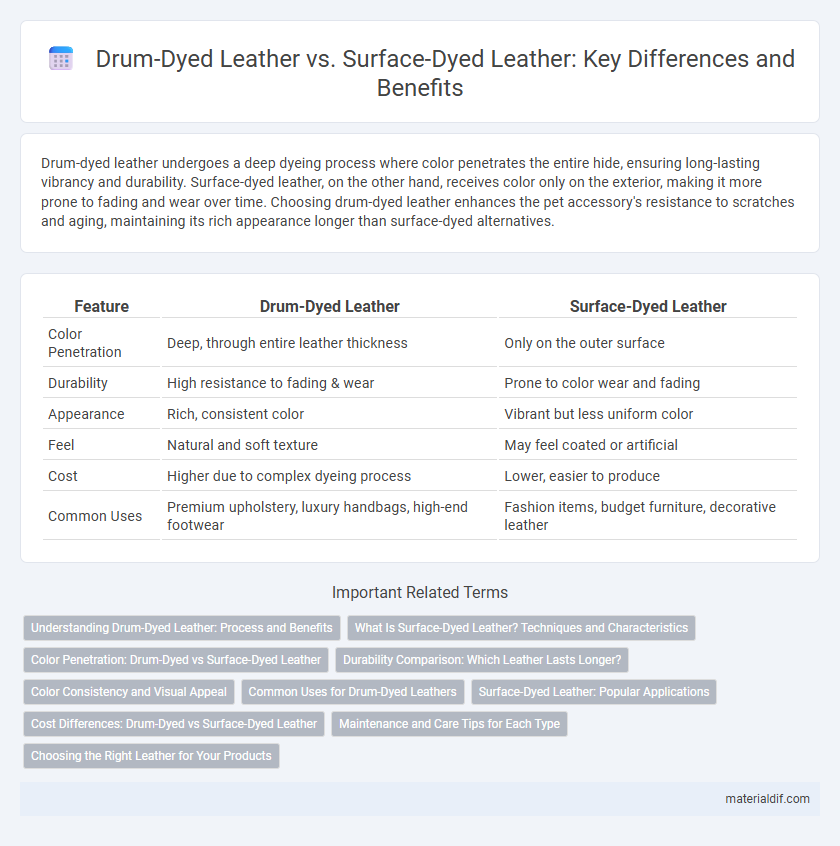Drum-dyed leather undergoes a deep dyeing process where color penetrates the entire hide, ensuring long-lasting vibrancy and durability. Surface-dyed leather, on the other hand, receives color only on the exterior, making it more prone to fading and wear over time. Choosing drum-dyed leather enhances the pet accessory's resistance to scratches and aging, maintaining its rich appearance longer than surface-dyed alternatives.
Table of Comparison
| Feature | Drum-Dyed Leather | Surface-Dyed Leather |
|---|---|---|
| Color Penetration | Deep, through entire leather thickness | Only on the outer surface |
| Durability | High resistance to fading & wear | Prone to color wear and fading |
| Appearance | Rich, consistent color | Vibrant but less uniform color |
| Feel | Natural and soft texture | May feel coated or artificial |
| Cost | Higher due to complex dyeing process | Lower, easier to produce |
| Common Uses | Premium upholstery, luxury handbags, high-end footwear | Fashion items, budget furniture, decorative leather |
Understanding Drum-Dyed Leather: Process and Benefits
Drum-dyed leather undergoes a unique tanning process where hides are immersed in large rotating drums filled with dye, allowing the color to penetrate deeply and uniformly. This method enhances the leather's durability, ensuring the dye reaches the core fibers, which provides superior colorfastness and resistance to fading compared to surface-dyed leather. As a result, drum-dyed leather maintains its rich hue and tensile strength over time, making it ideal for high-quality leather goods.
What Is Surface-Dyed Leather? Techniques and Characteristics
Surface-dyed leather undergoes a coloring process where dye is applied only to the outer layers, resulting in a uniform and vibrant finish without penetrating the hide fully. Techniques include spraying, padding, or brushing, which allow precise control over color intensity and design patterns while preserving the leather's natural grain and texture. This method tends to be more cost-effective than drum-dying but may show wear over time as the color sits atop the surface rather than deeply infused.
Color Penetration: Drum-Dyed vs Surface-Dyed Leather
Drum-dyed leather exhibits deep color penetration as the hides are immersed in dye within a rotating drum, allowing the dye to saturate the entire thickness of the leather. Surface-dyed leather only has dye applied to the outer layer, resulting in color limited to the surface and increased vulnerability to wear and fading. The superior colorfastness of drum-dyed leather makes it ideal for high-quality leather goods requiring durability and consistent coloration.
Durability Comparison: Which Leather Lasts Longer?
Drum-dyed leather exhibits superior durability compared to surface-dyed leather due to its color penetration throughout the entire hide, ensuring resistance to fading and wear over time. Surface-dyed leather tends to show scratches and discoloration more quickly since the dye only coats the exterior, leading to accelerated aging and diminished lifespan. Consequently, drum-dyed leather remains robust and visually appealing for a longer period, making it ideal for high-use applications.
Color Consistency and Visual Appeal
Drum-dyed leather achieves superior color consistency by immersing the hides in dye, allowing the pigment to penetrate deeply and uniformly, resulting in rich, vibrant hues that resist fading and wear. Surface-dyed leather, on the other hand, deposits color only on the exterior, often leading to uneven coloration and faster fading with use. The deep saturation of drum-dyed leather enhances its visual appeal by maintaining a vibrant, consistent color throughout the material, making it preferred for high-quality leather goods that demand durability and aesthetic longevity.
Common Uses for Drum-Dyed Leathers
Drum-dyed leather is commonly used in high-end furniture, automotive interiors, and luxury footwear due to its uniform color penetration and enhanced durability. This dyeing method ensures deep color saturation, making it ideal for products that require both aesthetic appeal and long-lasting wear. Drum-dyed leather also performs well in applications where resistance to fading and abrasion is critical, such as designer handbags and premium upholstery.
Surface-Dyed Leather: Popular Applications
Surface-dyed leather is widely used in furniture upholstery and automotive interiors due to its vibrant color options and uniform appearance. This leather type is preferred for products requiring consistent coloration and easier repairability, such as handbags and footwear. Its surface treatment enhances resistance to wear and environmental factors, making it ideal for fashion accessories and interior design elements.
Cost Differences: Drum-Dyed vs Surface-Dyed Leather
Drum-dyed leather involves immersing hides in large drums to ensure deep, uniform color penetration, resulting in higher production costs due to longer processing times and specialized equipment. Surface-dyed leather is treated only on the outer layer, making it less expensive but more prone to color fading and scratches. The cost difference typically reflects the durability and quality, with drum-dyed leather priced 20-40% higher than surface-dyed alternatives.
Maintenance and Care Tips for Each Type
Drum-dyed leather, infused with color throughout its fibers, offers superior resistance to wear and fading, requiring minimal maintenance beyond regular dusting and occasional conditioning with pH-balanced leather creams. Surface-dyed leather, with dye applied only to the outer layer, demands more frequent conditioning and gentle cleaning to prevent color loss and surface cracks; using leather-specific cleaners and avoiding excessive moisture helps preserve its finish. Both types benefit from protection against direct sunlight and humidity, which can deteriorate leather quality over time.
Choosing the Right Leather for Your Products
Drum-dyed leather offers deep, uniform color penetration by immersing hides in dye, resulting in enhanced durability and resistance to fading, ideal for products requiring longevity and consistent appearance. Surface-dyed leather receives color only on the exterior, making it more susceptible to scratches and wear, suitable for items where texture and finish variety are priorities. Selecting between drum-dyed and surface-dyed leather depends on balancing factors like intended product use, desired durability, and aesthetic preferences.
Drum-Dyed Leather vs Surface-Dyed Leather Infographic

 materialdif.com
materialdif.com